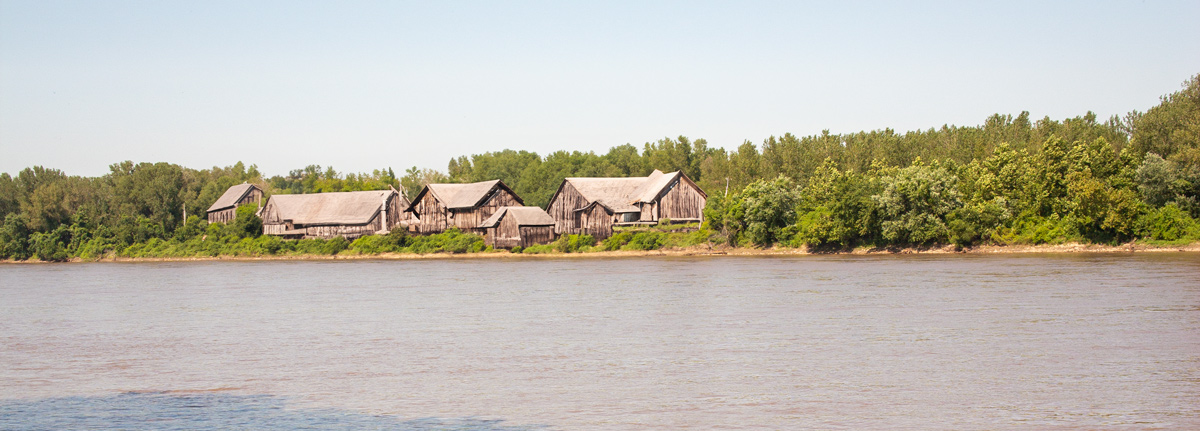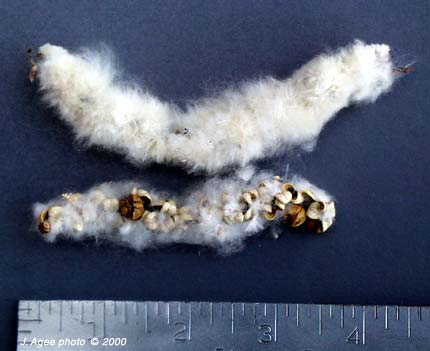The expedition travels about ten miles reaching La Charrette—the last settlement of “white people on this River . . . .” Here the captains meet experienced trader Régis Loisel who shares valuable information about the people and places between here and the Knife River Villages. The villagers sell them milk and eggs, and Lewis collects a cottonwood specimen.
The Village of La Charrette
by Yellowstone Public Radio[1]Originally aired weekdays by Yellowstone Public Radio during the Bicentennial observance of 2003-2006. Narrated by Hal Hansen. Scripts by Whit Hansen and Ed Jacobson. Produced by Leni Holliman. © … Continue reading
La Charrette Arrival
La Charrette Recreation
© 2015 August 2 by Kristopher K. Townsend. Permission to use granted under the Creative Commons Attribution-Share Alike 4.0 International license.
The above image was created with artificial intelligence—the log cabins were added to a modern photo of the Missouri River in the general area of present-day Marthasville, Missouri. Any settlement this close to the river would not have lasted long and likely the buildings would have been much smaller. Most of the trees would have been removed for buildings, firewood, and pasture.
towards evening we arrived at a French Village called Saint Johns or Charette on the North side of the River. this small Village, is the last settlement of white people on this River; we encamped near it—
—Joseph Whitehouse
Meeting Régis Loisel
here we met with Mr. Louisell [Régis Loisel] imedeately down from the [Cedar] Isld. Situated in the Countrey of the Suxex [Sioux] 400 Leagues up he gave us a good Deel of information Some letters he informed us that he Saw no Indians on the river below the Poncrars—
—William Clark
La Charette Creek
About 9 miles higher up, and 69, from the Mississippi, Chaurette Creek falls in on the N. side. it is 20 yards wide at it’s mouth, waters a tolerable country well covered with timber, but is of no great extent . . . . —immediately below the mouth of this creek five French families reside, who subsist by hunting and a partial trade wich they mantain with a few detatched Kickapoos who hunt in their neighbourhood.[2]Meriwether Lewis, “A Summary view of the Rivers and Creeks, which discharge thems[elves] into the Missouri . . . ” in Moulton, Journals, 3:338.
Lost Specimen No. 4
No. 4. . . . this specimine is the seed of the Cottonwood which is so abundant in this country, it has now arrived at maturity and the wind when blowing strong drives it through the air to a great distance being supported by a parrishoot of this cottonlike substance which gives the name to the tree in some seasons it is so abundant as to be troublesome to the traveler—
—Meriwether Lewis
Moulton identifies this lost specimen, received by John Vaughn in 1805 (see The Donation Book), as Populus deltoides, cottonwood.[3]Gary E. Moulton, ed. Journals, “Fort Mandan Miscellany”, vol 3:452, 466.
Weather Diary
strawbury in the praries ripe and abundant
—Meriwether Lewis
Notes
| ↑1 | Originally aired weekdays by Yellowstone Public Radio during the Bicentennial observance of 2003-2006. Narrated by Hal Hansen. Scripts by Whit Hansen and Ed Jacobson. Produced by Leni Holliman. © 2003 by Yellowstone Public Radio. |
|---|---|
| ↑2 | Meriwether Lewis, “A Summary view of the Rivers and Creeks, which discharge thems[elves] into the Missouri . . . ” in Moulton, Journals, 3:338. |
| ↑3 | Gary E. Moulton, ed. Journals, “Fort Mandan Miscellany”, vol 3:452, 466. |


